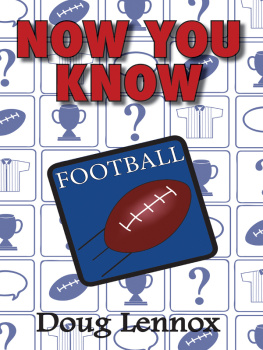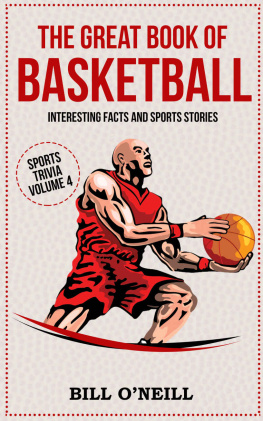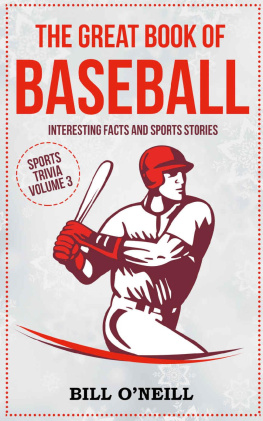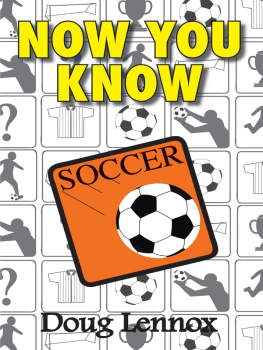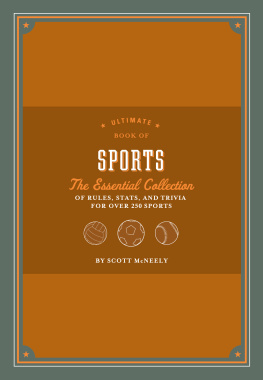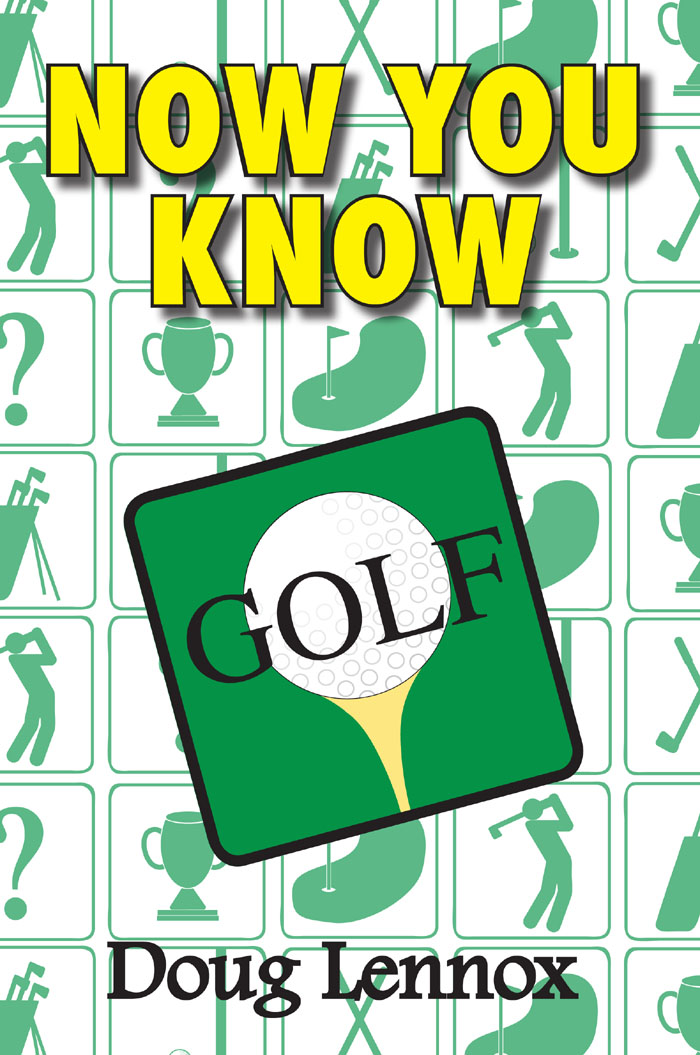Now You Know Golf
preface
Golf is a mysterious game. It is a great puzzle to understand why anyone would want to engage in an activity whose aim, as Winston Churchill famously put it, is to hit a very small ball into an even smaller hole, with weapons singularly ill-designed for the purpose. And why this game should have been so enthusiastically received in Scotland, where the modern game came into existence, is surely itself one of the great insoluble mysteries of the universe.
But golf is also a fascinating and seductive game, rife with appeal and challenge. To be on the links in the midst of nature on a dewy morning, to face golfs seemingly infinite variety of circumstances (from shot to shot, hole to hole, course to course), to experience the camaraderie of other golfers, to marvel at the talents of the games great players, to understand the physics that govern much of golfs world, to lose oneself in the ancient traditions that permeate the sportall of these elements and more explain why, from St. Andrews to Tokyo, golf has been embraced as one of mankinds most enchanting and enjoyable activities.
In this book I have delved into all these subjects and beyond to shed light on many of golfs most puzzling, idiosyncratic, and diverting mysteries. I hope this books many questions, answers, lists, facts, statistics, and sidebars, as well as its occasional moment of couched speculation (inevitable in any investigation into the often-patchy history of golf), will not only inform and entertain readers, but also enhance their enjoyment of the links, especially on those occasions when that very small ball, as Churchill put it, simply refuses to go into that even smaller hole.

the hole story
Who gave golf its hole?
The precise origin of the game of golf is not known. It is generally agreed among historians that games involving pebbles or small balls being struck with sticks across open ground towards elevated targets have existed worldwide for eons. But the first recorded reference to such a game, in which the goal was to sink the ball into a hole in the ground, is from 943 AD China. The Dongxuan Records, written by Wei Tai of the Song Dynasty, describe the Chinese game of chuiwan, which was played in a circuit on a lawn with many holes. Popular with royalty and commoners alike, chuiwan was often depicted in Chinese poetry, opera, and painting until the middle of the Ming Dynasty, in the 15th century, when it disappeared. While it is commonly contended that the Scottish introduced the hole to golf, Chinese historians hold that trade between East and West during the Middle Ages might have easily introduced chuiwan-like games to Europe, although no records show early European versions of the game employing a hole.
Who first brought golf to Scotland?
As early as 1262, the Flemish played chole, a game in which a ball is struck by a club across a field towards a goal post. In 1421, during the Hundred Years War, Hugh Kennedy, Robert Stewart, and John Smale, three Scottish soldiers, first played chole while their regiment was in western France to help French forces fight the English at the Battle of Baug. The English were defeated, and the trio brought chole back to Scotland, where the game eventually evolved into modern golf.
Quickies
Did you know
early golf club makers in Scotland were also bow makers for archery?
What was colf?
Many golf-like games sprung up simultaneously across Europe in the Middle Ages. One such early cousin of golf was the Dutch game colf. Extremely popular in the Netherlands from the 13th through the 17th centuries, colf was originally played in city squares or streets, and involved driving a ball with a hockey stick-like club towards a pole or natural target. Due to broken windows and injuries caused by game play, in the mid-1400s colf was banished to the countryside. In winter, colf was played on frozen canals. A popular subject for period paintings, winter colf is considered by many to also be a predecessor to ice hockey.
What is kolf?
Kolf is the singular term for the Dutch game historically known as kolven, which was extremely popular in the Netherlands in the 18th and 19th centuries. A variation of the extinct Dutch outdoor game of colf, it is played indoors on a small court and consists of hitting a ball with a stick along the floor between two target poles. Though its popularity has faded considerably, kolf still has a small following today in the Netherlands. Like colf, the word kolf is often believed to be the origin of the word golf.
The 12 Oldest Golf Clubs Outside the Island of Great Britain
Royal Calcutta Golf Club, Kolkata, India (1829)
Pau Golf Club, Billre, France (1856)
Royal Montreal Golf Club, Montreal, Quebec, Canada (1873)
Bangalore Golf Club, Bengaluru, India (1876)
Royal Belfast, Belfast, Northern Ireland (1881)
Curragh Golf Club, County Kildare, Ireland (1883)
Oakhurst Links, White Sulphur Springs, West Virginia, USA (1884)
Royal Cape Golf Club, Wynberg, Cape Town, South Africa (1885)
St. Andrews Golf Club, Yonkers, New York, USA (1888)
Hong Kong Golf Club, Hong Kong, China (1889)
Shinnecock Hills Golf Club, Southampton, New York, USA (1891)
Royal Adelaide Golf Club, Adelaide Australia (1892)
What is the origin of the word golf?
The word golf first appeared in a Scottish statute issued in 1457 by James II, King of Scots, banning the game. In Scotland, from the Middle Ages until the mid-1800s, the printed word saw many variations in spelling, including gouff, goiff, goff, gowff, and golph. The exact etymology is not known, though it is possible that the word derived from the names of the similar Dutch games colf or kolfterms which themselves derive from the Old Norse word kolfr, meaning club. Yet, interestingly, there are no recorded instances of the Scottish term being spelled with the initial letters c or k, so it is equallyor perhaps morelikely that the word evolved from the old Scottish word gouf, meaning to strike.
Five Rarely Recorded Royal & Ancient Moments in Scots Golf
1502, at PerthJames IV, King of Scots, lifts a ban on golf, then purchases clubs himself.
1562, at MontroseThe 4th Earl of Montrose, James Graham, records in his diary that he played golf the day before his wedding.
1567, at Seton HouseMary, Queen of Scots, plays golf within days of her husbands assassination.
1619, at DornochThe 14th Earl of Sutherland, John Gordon, age 16, receives his first set of clubs, purchased for 10.
1641, at Leith Links: King Charles I receives news of the Irish Rebellion while playing golf.
Why did James II, King of Scots, ban golf in 1457?
By the mid-15th century, golf was extremely popular in Scotland. So popular, in fact, that the Parliament of James II felt it was necessary to issue a decree banning the game. At the time, 1457, Scotland was preparing to defend itself against possible invasion by the English, and golf was distracting soldiers from archery practice. In both 1470 and 1491 the ban was extended, but it was by then ignored by the Scottish people. In 1502, with the Treaty of Glasgow between Henry VII of England and James IV of Scotland, the ban on golf was finally lifted. James IV almost immediately took up the sport himself.

